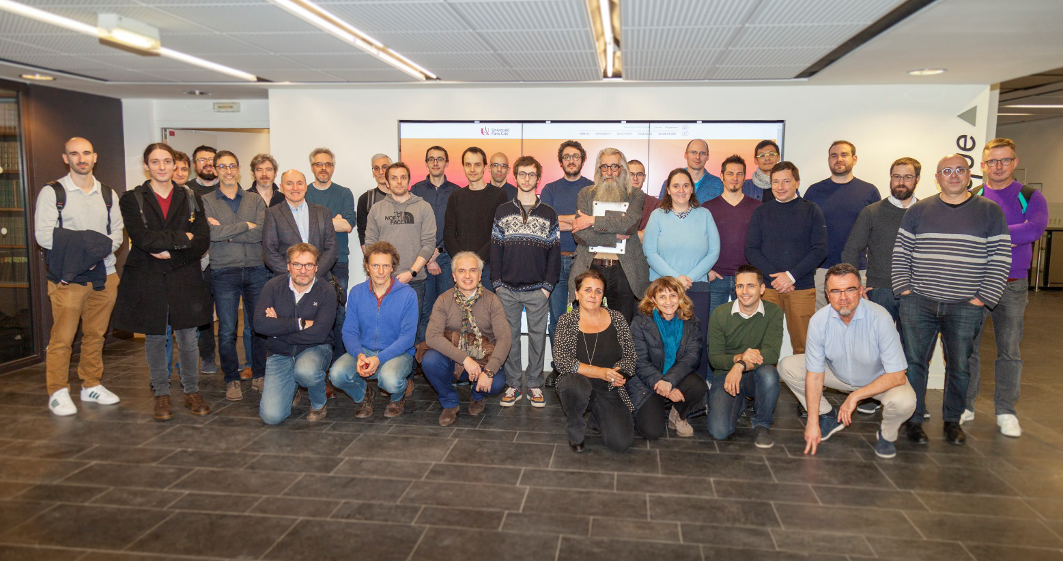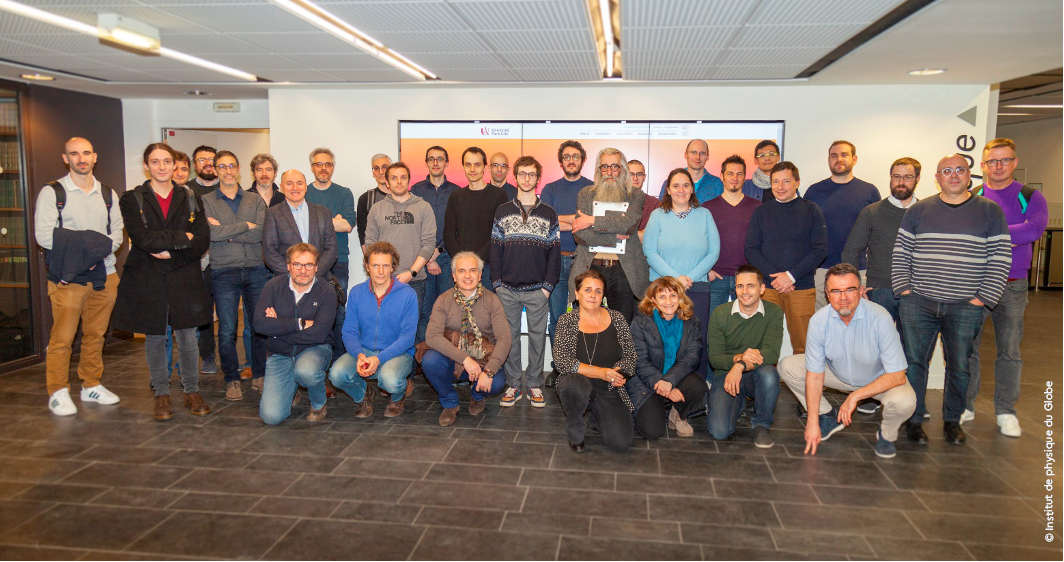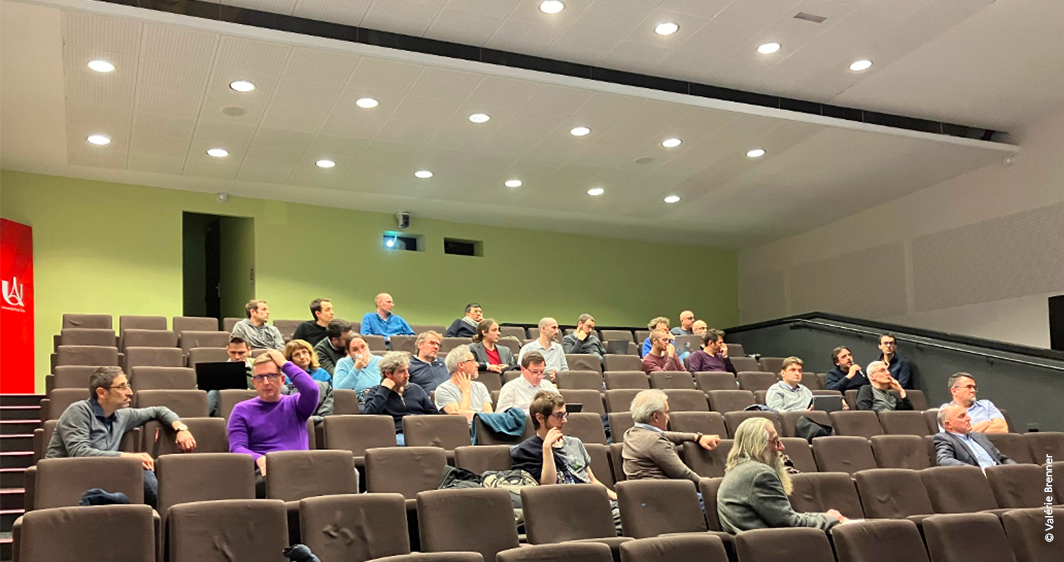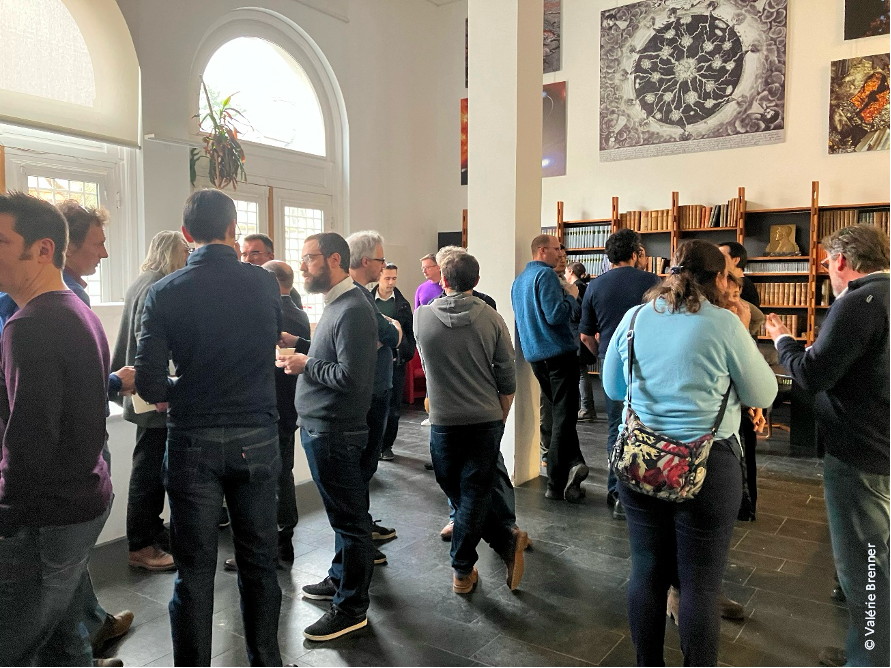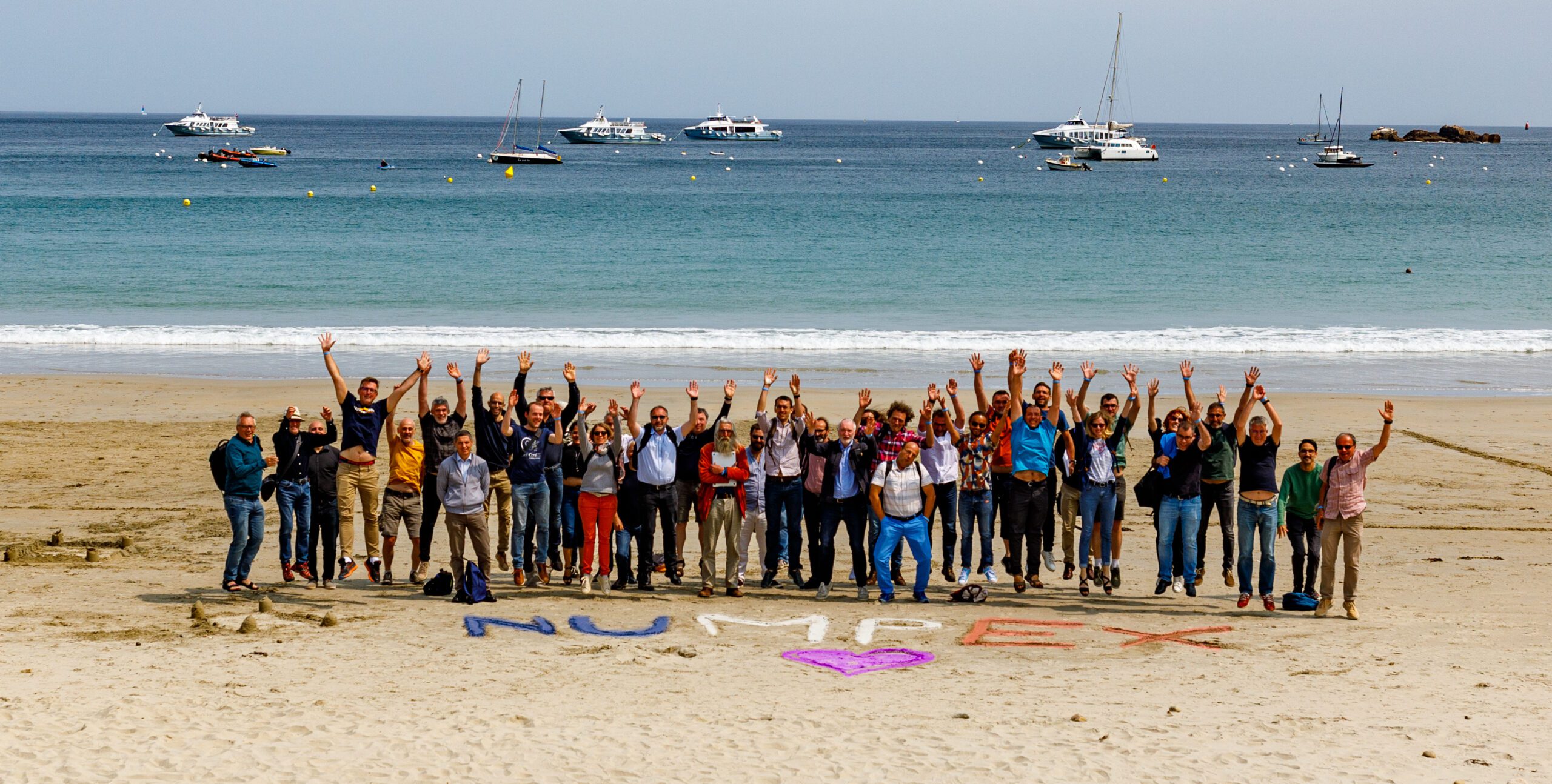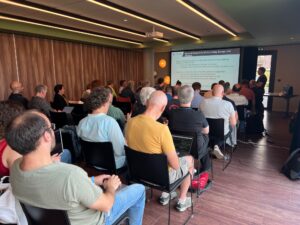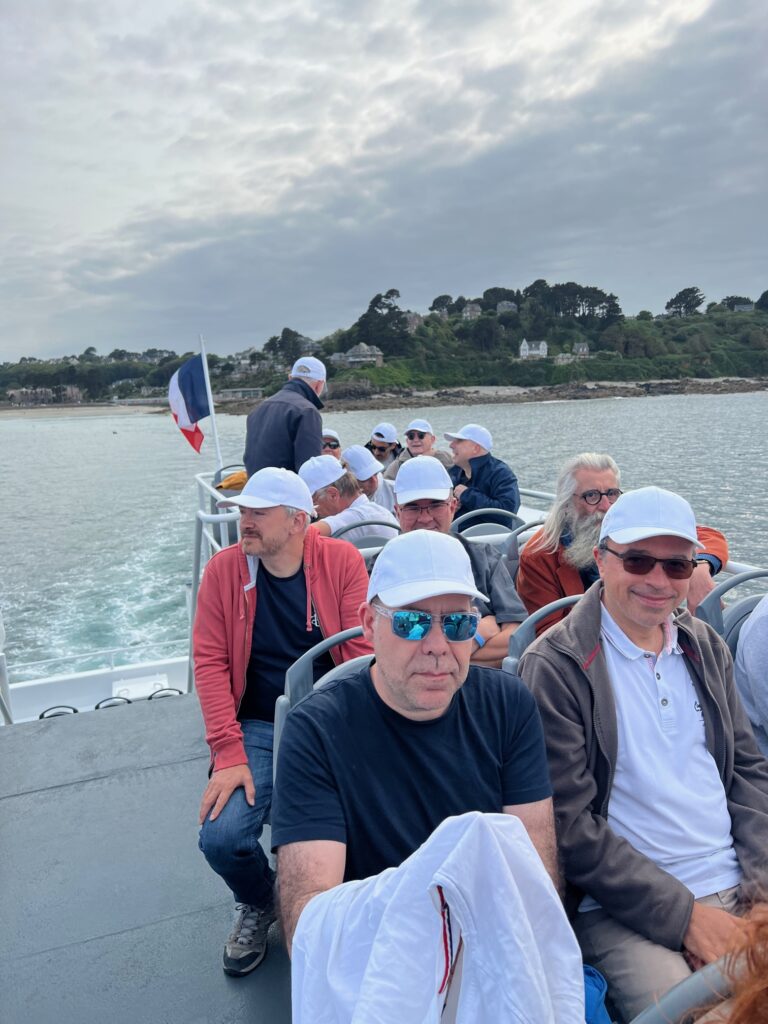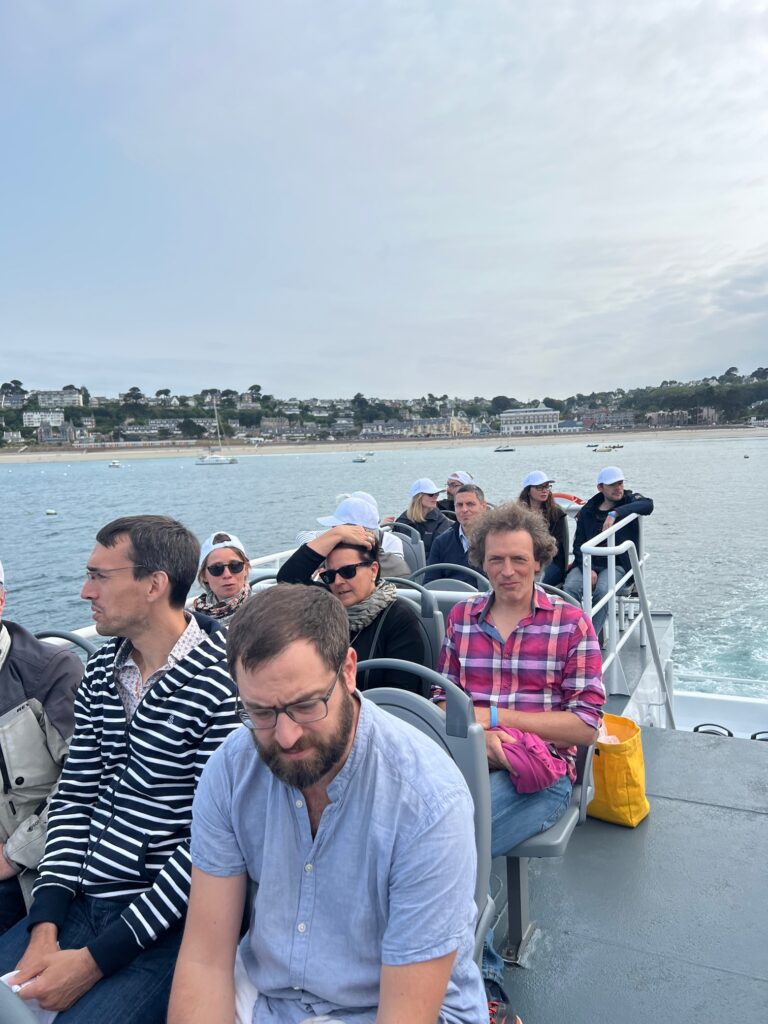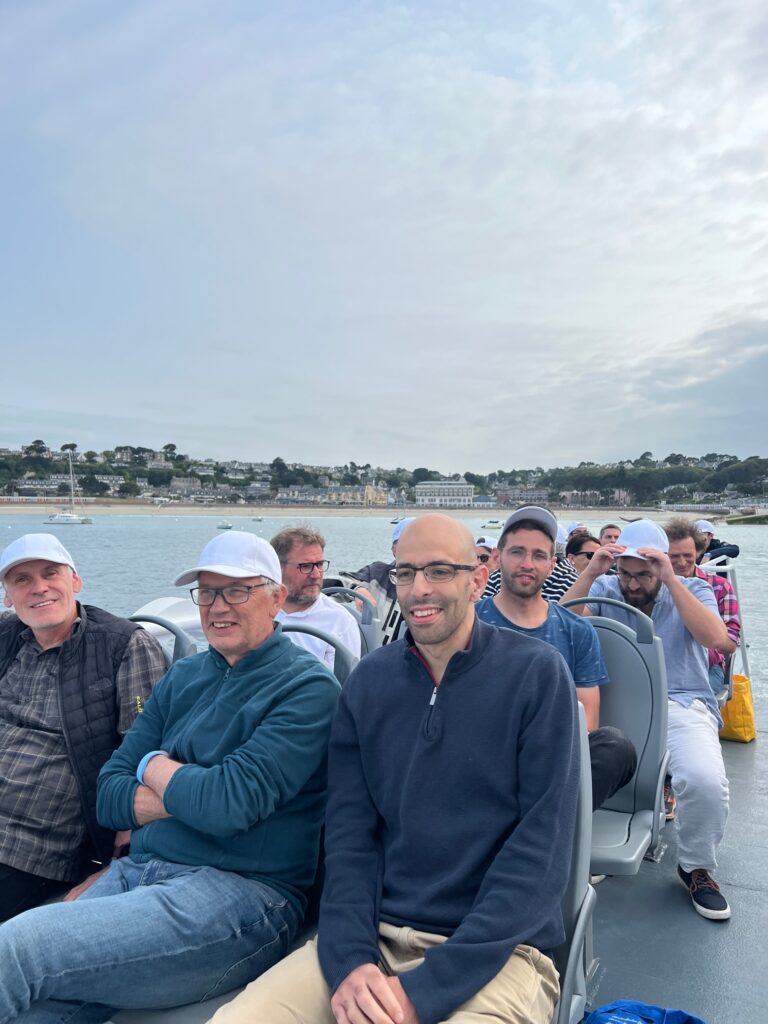The second co-design and co-development workshop of Exa-DI on "Block-structured AMR @Exascale"
The second co-design/co-development workshop of the Exa-DI project (Development and Integration) of the PEPR NumPEx was dedicated to the computation and communication motif “Block-structured AMR @Exascale”. It took place on February 6 and 7, 2024 at the “Grand Amphi” of the “Institut de Physique du Globe de Paris” in Paris.
This face-to-face workshop brought together, for two days, Exa-DI members, members of the other NumPEx projects (Exa-MA: Methods and Algorithms for Exascale, Exa-SoFT: HPC Software and Tools, Exa-DoST: Data-oriented Software and Tools for the Exascale and Exa-AToW: Architectures and Tools for Large-Scale Workflows), Application demonstrators (ADs) from various research and industry sectors and Experts to discuss advancements and future directions for block structured AMR at exascale.
This workshop is the second co-design/co-development workshops in the series whose main objective is to promote software stack co-development strategies to accelerate exascale development and performance portability of computational science and engineering applications. Discussions included challenges in co-design and co-development process, key questions and most urgent issues for collective exploration to build links across NumPEx and the applications, and initiatives promoting exascale software stack sustainability, emphasizing collaboration and innovation.
Key sessions included
- Introduction and Context: Setting the stage for the workshop’s main theme.
- Attendees Self-Introduction: Allowing attendees to introduce themselves and their interests.
- Various Technical Sessions: These sessions featured talks on topics such as exascale performance evaluation and advancements in exascale simulations for different applications like astrophysics simulations, flame fronts and gas/liquid interfaces as well as long molecular dynamic simulations with polarizable force fields. In addition, two experts gave presentations on the Samurai and Hercule libraries and a developer of the massively parallel open-source WarpX Particle-In-Cell code presented his feedback on the implementation of AMReX framework.
- Discussions and RoundTables: These sessions provided opportunities for attendees to engage in discussions and share insights on the presented topics.
Invited speakers
- Jean-Pierre Vilotte from CNRS, member of Exa-DI who provided the introductory context for the workshop.
- Maxime Delorme & Arnaud Durocher from CEA, presenting Dyablo, an AMR code for astrophysics simulations in the exascale era.
- Loic Straffela from Ecole Polytechnique, discussing optimizing I/O performance for AMR Code.
- Igor Chollet from Sorbonne Université, presenting ANKH, a scalable alternative to FFT-based approaches for energy computation on accelerator-based exascale architectures.
- Loic Gouarin from Ecole Polytechnique, presenting SAMURAI: Structured Adaptive mesh and Multi Resolution on Algebra of Intervals
- Luca Fedeli from CEA, discussing implementation of AMReX for WaprX, a Particule-In-Cell code for the exascale era.
- Vincent Moureau from CNRS addressing Dynamic Mesh Adaptation of massive unstructured grids for the simulation of flame fronts and gas/liquid interfaces.
Outcomes and impacts
A very interesting and stimulating outcome that was discussed and decided during this workshop is the set-up of a working group addressing a suite of shared and well specified proxy-apps and mini-apps for this co-design computation and communication motif. Several teams of ADs have expressed their interest in participating in this working group which is being formed and whose first meeting should take place soon.
The discussions allowed us to determine the different goals of this working group. In particular, the criteria of the common mini-apps and proxy-apps that will be built was defined. They have to (i) represent algorithms, data structures and layouts, and other computational and communication characteristics across the different application demonstrators, (ii) leverage and integrate logical suites of software components (libraries, frameworks, tools), (iii) measure interoperability levels, performance gain and/or trade-off between components, performance portability, scalability and software quality and (iv) develop collaborative and shared continuous integration and benchmarking methodologies with standardized performance tools to guide optimizations, together with reference meta-data and specifications models.
The second main goal of this working group, that is also a main goal of the workshop series, is to identify the human resources and expertise in the Computational and Data Team (CDT) that Exa-DI needs to deploy. In the co-design/co-development process, the CDT will ensure the interface between the NumPEx projects and the AD teams to support the co-design and co-development of the mini-apps and proxy-apps suite, together with reference data models for sharing specifications and benchmarking/testing results.
Attendees
- Jean-Pierre Vilotte, CNRS and member of Exa-DI
- Valérie Brenner, CEA and member of Exa-DI
- Jérôme Bobin, CEA and member of Exa-DI
- Mark Asch, Université Picardie and member of Exa-DI
- Julien Bigot, Inria and member of Exa-DI
- Karim Hasnaoui, CNRS and member of Exa-DI
- Christophe Prud’homme, Université de Strasbourg and member of Exa-MA
- Hélène Barucq, Inria and member of Exa-MA
- Isabelle Ramière, CEA and member of Exa-MA
- Vincent Faucher, CEA and member of Exa-MA
- Christian Perez, Inria and member of Exa-MA
- Raymon Namyst, Université de Bordeaux and member of Exa-SoFT
- Alfredo Butari, CNRS and member of Exa-SoFT
- Marius Garenaux, Université de Rennes and member of Exa-AToW
- Olivier Martineau, Université de Rennes and member of Exa-AToW
- Vincent Moureau, CNRS and application demonstrator
- Maxime Delorme, CEA and application demonstrator
- Arnaud Durocher, CEA and application demonstrator
- Allan Sacha, CEA and application demonstrator
- Damien Chapon, CEA and application demonstrator
- Grégoire Doeble, CEA and application demonstrator
- Dominique Aubert, Université de Strasbourg and application demonstrator
- Olivier Marchal, Université de Strasbourg and application demonstrator
- Igor Cholet, Université Paris 13 and application demonstrator
- Jean Philippe Piquemal, Sorbonne Université and application demonstrator
- Louis Lagardère, Sorbonne Université and application demonstrator
- Olivier Adjoua, Sorbonne Université and application demonstrator
- Stefano Frambati, Total Energies and application demonstrator
- Luca Fedeli, CEA
- Loic Strafella, École polytechnique
- Loic Gouarin, CNRS
- Marc Massot, École polytechnique
- Pierre Matalon, École polytechnique
- Geoffroy Lesur, CNRS and member of the PEPR Origins
The first co-design and co-development workshop of Exa-DI on "Efficient Discretisation for PDE@Exascale"
The first co-design/co-development workshop of the Exa-DI project (Development and Integration) of the PEPR NumPEx had the topic “Efficient Discretisation for PDE@Exascale” and took place on November 7 and 8, 2023 at the Amphithéâtre J. Talairach (Neurospin) at CEA Saclay in Gif-sur-Yvette.
This face-to-face workshop brought together for two days Exa-DI members, members of the other NumPEx projects (Exa-MA: Methods and Algorithms for Exascale, Exa-SofT: HPC Software and Tools, Exa-DoST: Data-oriented Software and Tools for the Exascale and Exa-AToW: Architectures and Tools for Large-Scale Workflows), Application demonstrators (ADs) from various research and industry sectors and Experts to discuss advancements and future directions for efficient discretisation of physics-based partial differential equations (PDEs) at exascalein discretizing partial differential equations (PDEs) efficiently for exascale applications.
This workshop is the first co-design/co-development workshops in the series whose main objective is to promote co-software stack development strategies to accelerate exascale development and performance portability of computational science and engineering applications. Discussions included challenges in co-design and co-development process, key questions and most urgent issues for collective exploration building links across NumPEx and the applications, and initiatives promoting exascale software stack sustainability, emphasizing collaboration and innovation.
Key sessions included
- Introduction and Context: Setting the stage for the workshop’s main theme.
- Attendees Self-Introduction: Allowing attendees to introduce themselves and their interests.
- Various Technical Sessions: These sessions featured talks on topics like exascale performance evaluation and advancements in exascale simulations for different applications like durable aircraft prototype, CO2 sequestration, turbomachinery, Earth dynamo simulations, dynamic energy simulation for urban buildings, structural and fluid mechanics simulations, geoscience simulations and finally plasma turbulence simualtions. In addition, an expert does a presentation of Kokkos.
- Discussions and RoundTables: These sessions provided opportunities for attendees to engage in discussions and share insights on the presented topics.
Invited speakers
- Jean-Pierre Vilotte from CNRS, member of Exa-DI who provided the introductory context for the workshop.
- Eric Savin from ONERA, discussing exascale performance evaluation for a durable aircraft prototype.
- Henri Calandra from TotalEnergies, discussing exascale multiphysics simulators for CO2 sequestration and monitoring.
- Christian Trott from SNL, presenting on Kokkos.
- Julien Vanharen & Loic Marechal from Inria, addressing exascale simulations for turbomachinery.
- Nathanaël Schaeffer & Hugo Frezat from CNRS, exploring machine learning applications in Earth dynamo simulations.
- Vincent Chabannes & Christophe Prud’homme from Université de Strasbourg, discussing dynamic energy simulation for urban buildings.
- Olivier Jamond from CEA, presenting a new generation HPC PDE solver targeting industrial applications in structural and fluid mechanics, the MANTA project.
- Soleiman Yousef from IFP Energies nouvelles, discussing performance issues in geoscience applications.
- Virginie GrandGirard from CEA, discussing the GYSELA code for plasma turbulence simulations.
Outcomes and impacts
A very interesting and simulating outcome that was discussed and decided during this workshop is the set-up of a working group addressing a suite of shared and well specified proxy-apps and mini-apps for this co-design computation and communication motif. Several teams of ADs have expressed their interest in participating in this working group which is being formed and whose first meeting should take place next January.
The discussions allowed us to determine the different goals of this working group. In particular, the criteria of the common mini-apps and proxy-apps that will be build was defined. They have to (i) represent algorithms, data structures and layouts, and other computational and communication characteristics across the different application demonstrators, (ii) leverage and integrate logical suites of software components (libraries, frameworks, tools), (iii) measure interoperability levels, performance gain and/or trade-off between components, performance portability, scalability and software quality and (iv) develop collaborative and shared continuous integration and benchmarking methodologies with standardized performance tools to guide optimizations, together with reference meta-data and specifications models.
The second main goal of this working group that is also a main goal of the workshop series is to identify the human resources and expertise in the CDT (Computational and Data Team) that Exa-DI needs to deploy. In the co-design/co-development process, the CDT will ensure the interface between the NumPEx projects and the ADs teams to support the co-design and co-development of the mini-apps and proxy-apps suite, together with reference data models for sharing specifications and benchmarking/testing results.
Attendees
- Jean-Pierre Vilotte, CNRS and member of Exa-DI
- Valérie Brenner, CEA and member of Exa-DI
- Jérôme Bobin, CEA and member of Exa-DI
- Mark Asch, Université Picardie and member of Exa-DI
- Julien Bigot, Inria and member of Exa-DI
- Karim Hasnaoui, CNRS and member of Exa-DI
- Christophe Prud’homme, Université de Strasbourg and member of Exa-MA
- Hélène Barucq, Inria and member of Exa-MA
- Guillaume Latu, CEA and member of Exa-MA
- Raymond Namyst, Université de Bordeaux and member de Exa-SoFT
- Joshua Bowen, Inria and member of Exa-DoST
- Christian Robert Trott, Sandia National Laboratories
- Virginie Grandgirard, CEA and application demonstrator
- Youssef Soleiman, IFPEN and application demonstrator
- Stéphane de Chaisemartin, IFPEN and application demonstrator
- Ani Anciaux Sedrakian, IFPEN and application demonstrator
- Julien Vanharen, Inria and application demonstrator
- Loic Marechal, Inria and application demonstrator
- Nathanael Saeffer, CNRS and application demonstrator
- Hugo Frezat, CNRS and application demonstrator
- Savin Eric, Onera and application demonstrator
- Denis Gueyffier, Onera and application demonstrator
- Henri Calandra, Total Energies and application demonstrator
- Stefano Frambati, Total Energies and application demonstrator
- Olivier Jamon, CEA and application demonstrator
- Nicolas Lelong, CEA and application demonstrator
- Vincent Chabanne, Université de Strasbourg and application demonstrator
Unleashing the Power of Exascale Computing: Genci's 2022 Activity Report
We are thrilled to present the highly anticipated activity report of Genci for the year 2022.
As a leading organization responsible for providing powerful computational and data processing resources, Genci has been instrumental in driving scientific research and innovation at both the national and European levels.
With a mission to promote the use of supercomputing coupled with artificial intelligence, Genci has made significant strides in benefitting scientific research communities, academia, and industrial sectors. Join us as we explore the remarkable achievements showcased in this 68-page report.

Launching Innovative Programs and Initiatives:
Genci’s commitment to pushing the boundaries of computational capabilities is evident through the launch of several groundbreaking programs and initiatives. The report highlights key projects, such as:
- NumPEx: The NumPEx initiative aims to harness the power of supercomputing and AI to drive scientific progress. By providing researchers with cutting-edge computational resources, Genci enables them to tackle complex challenges across various scientific domains.
- Jules Verne Consortium for Exascale: Genci’s partnership in the Jules Verne Consortium demonstrates their dedication to advancing exascale computing. This collaboration fosters innovation and propels research in areas that were once unimaginable.
- CLUSSTER Project: The CLUSSTER project focuses on integrating cloud computing solutions into Genci’s infrastructure. By embracing the cloud, Genci enhances flexibility and scalability, enabling researchers to tackle data-intensive workloads with ease.
- New Supercomputer “Adastra”: Genci’s introduction of the state-of-the-art supercomputer “Adastra” marks a significant milestone. With its remarkable computational power, Adastra empowers researchers to tackle complex simulations, accelerate data analysis, and drive scientific breakthroughs.
Driving Quantum Computing Advancements:
Genci recognizes the immense potential of quantum computing and has made significant progress in this field. The report highlights notable achievements, including:
- National Hybrid Quantum Computing Platform: Genci has played a pivotal role in launching of this platform. This initiative fosters collaboration and enables researchers to explore the capabilities of quantum computing in solving real-world problems.
- Integration of Quantum Systems: Genci has acquired its first quantum systems, marking a significant step towards enabling researchers to harness the power of quantum computing. These systems pave the way for groundbreaking research and innovation in quantum-enabled applications.
- The Quantum Package: Genci’s Quantum Package (PAck Quantique) provides researchers with the necessary tools and resources to explore hybrid quantum computing systems. This initiative promotes the development of novel algorithms and applications that bridge classical and quantum computing.
Advancements in Artificial Intelligence:
Genci has embraced the transformative potential of artificial intelligence, as highlighted in the report:
Bloom Model: Genci’s Bloom Model showcases their efforts to develop cutting-edge AI algorithms and frameworks. By combining supercomputing with AI, Genci facilitates breakthrough research in machine learning, deep learning, and data analytics.
Contributing to Scientific Research and Industry:
Genci is dedicated to supporting scientific research communities, academia, and industrial sectors through different initiatives, as exemplified by their efforts in:
- Reusing Waste Heat: Genci’s innovative approach includes the valorization of waste heat generated by the Jean Zay supercomputer. This environmentally friendly initiative showcases Genci’s dedication to sustainability and efficient resource utilization.
- Grands Challenges: Genci actively supports researchers in tackling grand challenges, providing them with the computational resources needed to address complex problems across diverse scientific disciplines.
- Exemplary Simulations: The report presents compelling examples of simulations conducted with Genci’s resources, showcasing the impactful discoveries and advancements made possible through their support.
- Community of Large Industrial Groups: Genci’s collaboration with large industrial groups highlights their commitment to bridging the gap between academia and industry. By fostering partnerships, Genci facilitates the transfer of cutting-edge research and technological advancements into real-world applications.
Genci’s Regional and European Ecosystem:
The report highlights Genci’s active involvement in regional and European initiatives:
- Regional Initiatives: Genci actively contributes to regional development through initiatives like SiMSEO, Competence Center, and MesoNet. These programs encourage cooperation among research institutions and industries, which promotes innovation and contributes to economic growth..
- European Collaborations: Genci’s participation in European collaborations, such as PRACE, EuroHPC, EUPEX, and EPI SGA, underscores their commitment to establishing a strong European ecosystem for high-performance computing. These collaborations facilitate knowledge exchange, resource sharing, and foster a vibrant European research community.
The 2022 Activity Report by Genci demonstrates their commitment to empowering scientific research and driving innovation by integrating exascale computing, artificial intelligence, and quantum computing.
Through the launch of groundbreaking programs, the introduction of cutting-edge technologies, and collaborations with research communities and industry, Genci has made significant contributions to advancing scientific frontiers.
Their commitment to sustainable practices and regional and European partnerships further solidifies their position as a leading provider of computational resources.
As we look to the future, Genci continues to pave the way for transformative discoveries and breakthroughs in scientific research and technological innovation.
NumPEx Launches into Action with an Ambitious Kick-Off Agenda in Perros-Guirrec
In a series of dynamic sessions hosted from June 26th to 28th in the charming town of Perros-Guirrec, NumPEx embarked on an intensive kick-off event, setting the stage for a transformative journey in Exascale computing. Leaders, experts, and collaborators convened to delve into an agenda rich with insights,workshops, and collaborative initiatives.
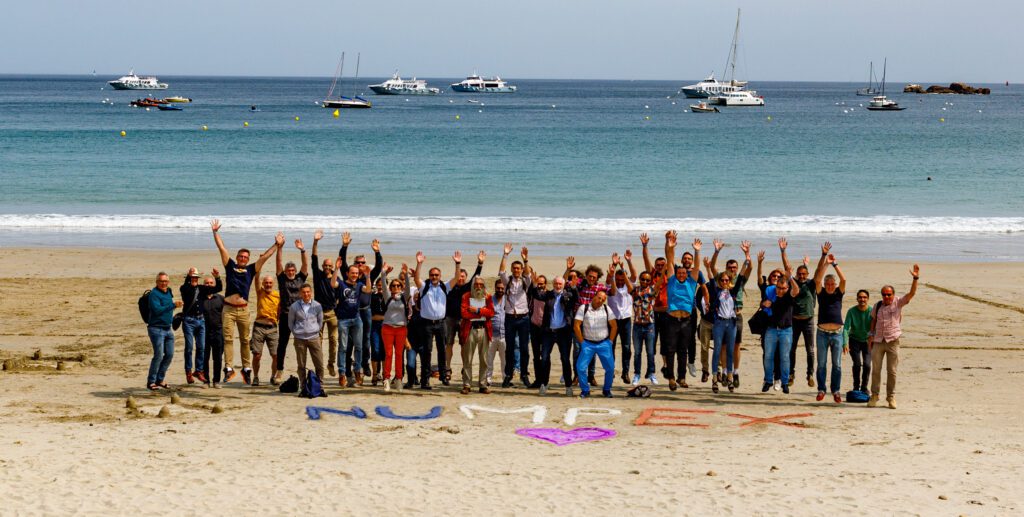
The kick-off began with a comprehensive introduction, outlining the objectives and significance of the NumPEx program, aiming to establish a common vision and foster collaboration to implement a coherent software stack and related processes by 2025, benefiting not only France but also Europe, in preparation for the Exascale machine. Key figures such as Jerome Bobin, Michel Dayde, and Jean-Yves Berthou elaborated on the program's goals and organizational structure. Board members shared their perspectives on the Exascale vision and roadmaps:
GENCI's Exascale Vision and Roadmap:
- Presentation of GENCI's role and missions, including hosting the Exascale project for EuroHPC.
- European HPC initiative partnership with EuroHPC and others, leveraging PRACE and GEANT.
- Introduction of the Jules Verne consortium, highlighting international and industrial partnerships.
- Vision of the European Exascale machine: addressing societal challenges, fostering innovation, and emphasizing HPC/IA data-centric convergence.
- Collaboration plans with NumPEx, including building a functional program, benchmark development, and product promotion.
Eviden Exascale Vision and Roadmap:
- Eviden's complex approach involving HPC, HPDA, IA, and quantum technologies with a focus on sovereign and European components.
- Involvement in the European integrated processor for Exascale machines (SiPearl) and collaborations with various technology projects.
- Collaboration with CEPP for application support and participation in technology projects related to Exascale, quantum, cloud, and more.
National and European Ecosystem:
- Introduction of EUPEX, a 4-year project with a budget similar to NumPEx, aiming to deploy a modular Exascale system using the OpenSequana architecture.
- Collaboration with NumPEx, potential for shared experiments and results, and exploration of common dissemination.
- Presentation of Data Direct Network (DDN) with a focus on AI and Lustre parallel file system, highlighting challenges and the importance of understanding NumPEx applications.
The afternoon continued with a tour of the five projects (PCs) within the NumPEx program:
- Exa-MA, which aims to design scalable algorithms and numerical methods for forthcoming exascale machines. Led by Christophe Prudhomme (Université de Strasbourg) and Helene Barucq (Inria).
- Exa-Soft, to develop a coherent, portable, efficient, and resilient software stack for exascale. Led by Raymond Namyst (Inria) and Alfredo Buttari (CNRS - Centre national de la recherche scientifique).
- Exa-DoST, to overcome challenges relating to data, notably storage, I/O, in situ processing, and smart analytics, in exascale supercomputers. Led by Gabriel Antoniu (Inria) and Julien Bigot (CEA).
- Exa-ATOW, to deal with large-scale workflows involving exascale machines. Led by François Bodin (Université de Rennes), Mark Asch (Université de Picardie Jules Verne (UPJV)), and Thierry Deutsch (CEA).
- Exa-DI, to ensure transverse co-design and software productivity for exascale supercomputers. Led by Jean-Pierre Vilotte (CNRS) and Valérie Brenner (CEA).
The day concluded with an emphasis on the collaborative efforts between NumPEx and other initiatives, with a focus on benchmark development, software-hardware links, and the overall goal of preparing for the challenges of the Exascale era.
The second day kicked off with an invigorating early morning jog along the seashore, setting a vibrant tone for a day filled with thematic workshops. Participants engaged in focused discussions on energy synergies, GPU integration, applications, co-design, gender/diversity/equity, software production integration, training, resilience, international collaborations, and artificial intelligence. Thematic workshops, led by domain experts, fostered collaboration within smaller groups, emphasizing the program's commitment to a transverse approach to Exascale challenges.
The final day commenced with a synthesis of workshop outcomes, highlighting the depth of discussions within each thematic area. Workshop leaders consolidated insights, offering a panoramic view of challenges and opportunities. Here is an overview of the key insights and strategic actions discussed during these workshops:
GPU Accelerators Workshop
In a dedicated workshop on GPU Accelerators, experts emphasized the pivotal role of Graphics Processing Units (GPUs) in achieving exascale computing. With 90-99% of large machine performance attributed to GPU acceleration, the workshop highlighted the need for applications to explore the potential of these powerful processors. Challenges discussed included new programming paradigms, code portability, data management, and the hardware landscape driven by gaming and artificial intelligence. The workshop outlined a comprehensive plan, including future workshops, analysis papers, tutorials, hackathons, and examples of successfully ported mini-apps.
Energy Workshop
The Energy Workshop focused on achieving Exascale computing within a power consumption limit of 20MW. Experts delved into environmental, scientific, technical, and societal dimensions, providing a roadmap for the HPC community. Key challenges identified included modeling system consumption, real-time measurement tools, resource prioritization based on societal impact, and the broader environmental impact of research activities. The action plan involves developing a performance and consumption model, optimization strategies, tools for users, and fostering links with external entities to incorporate energy considerations.
Gender Equity and Diversity Seminar
The action plan includes the establishment of a Code of Conduct, assessment of gender distribution, creation of a web platform for resources, education and training initiatives, awareness and outreach programs, and dedication to accessibility and recognition. NumPEx aims to create an inclusive and collaborative future, inviting all stakeholders to contribute to the initiatives.
AI Workshop
The AI Workshop explored the critical intersection of HPC and AI, addressing challenges and outlining a strategic plan for collaborative exploration. Key discussions included decision support tools for AI applications in HPC, optimizing runtimes for AI models, and converging HPC and AI usages. The action plan involves establishing an AI Working Group, conducting transversal workshops, and developing fundamental building blocks for a convergent future.
Training Strategies Workshop
The Training Strategies Workshop addressed the complexities of training in the context of the impending exascale era. Discussions included the scope and subjects of training programs, the creation of sustainable training models, and economic considerations in training initiatives. The workshop emphasized collaborative and inclusive training initiatives to prepare the scientific community for the challenges and opportunities of exascale computing.
International Collaborations Workshop
The International Collaborations Workshop focused on identifying challenges and setting objectives for enhanced collaborative frameworks on a European and global scale. Discussions covered scientific and technological challenges, the design and development of the exascale software stack, and strategic action plans. The outlined roadmap includes hosting workshops, exchanging insights and experiences, and strengthening collaborations with international entities.
National Centers Integration Workshop
The National Centers Integration Workshop aimed to align NumPEx with HPC infrastructures, emphasizing operational elements between computing centers and NumPEx 's targeted projects. Discussions covered operational assessment, cybersecurity, job profiling, and traceability. The workshop set a plan for regular video conferences, ensuring ongoing communication and collaboration.
Software Production Workshop
The Software Production Workshop focused on streamlining software development practices in the HPC domain. Challenges discussed included bridging silos, enforcing good practices, and amplifying impact. Insights and conclusions highlighted diverse development practices, sustainability models, and the deployment of continuous integration and certification. NumPEx 's commitment to advancing software production practices aims to foster innovation, collaboration, and sustainable development in HPC.
Exascale Resilience Workshop
The Exascale Resilience Workshop navigated complexities associated with exascale application deployment. Discussions covered diverse approaches across NumPEx PCs, key challenges, and strategic choices. The action plan involves listing and analyzing application needs, analyzing barriers to library adoption, and scrutinizing international solutions. NumPEx aims to foster collaborative solutions for enhanced application resilience at a global scale.
Applications and Co-Design Workshop
The Applications and Co-Design Workshop promoted co-development strategies for advanced application development. Discussions included challenges in co-design, key questions for collective exploration, building connections, and initiatives for sustainability. The workshop set the stage for upcoming co-development project workshops, emphasizing collaboration and innovation.

